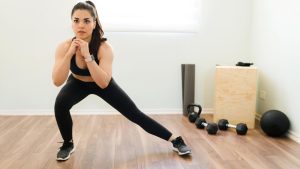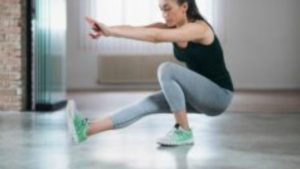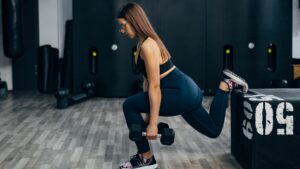The Best Squat Variations for Enhancing Stability in Runners

Importance of Stability in Running
Before diving into specific squat variations, understanding why stability matters in running is crucial. Stability forms the bedrock of efficient running mechanics. It helps prevent injuries, enhances control over movements, and optimizes energy transfer, ultimately boosting performance.
Squat Variations for Stability Enhancement
1. Single-Leg Squats (Pistol Squats)
Benefits: These squats emphasize balance and unilateral strength, crucial for stabilizing muscles.
Execution: Stand on one leg, extend the other leg in front, then squat down while maintaining balance. Use support if needed initially.

2. Split Squats
Benefits: Great for improving stability in the hip and knee joints, vital for runners’ stability.
Execution: Step one foot backward, lowering the back knee toward the ground while keeping the front knee above the ankle. Return to the starting position.
3. Goblet Squats
Benefits: Enhances core stability and teaches proper squat form, promoting overall stability.
Execution: Hold a dumbbell or kettlebell close to the chest, squat down, and push the hips back, ensuring proper alignment.
4. Bulgarian Split Squats
Benefits: Focuses on unilateral strength, balance, and stability, mimicking running mechanics.
Execution: Elevate one foot on a bench or platform behind you, perform a squat by lowering the back knee towards the ground.

Implementing Squat Variations
For 21-year-old males and females aiming to enhance stability for running, incorporating these squat variations into their workout routines is beneficial. Begin with bodyweight variations and gradually progress to adding resistance, focusing on form and stability throughout.
So.
Squat variations play a pivotal role in enhancing stability for runners. 21-year-old males and females looking to improve their stability in running can benefit immensely from integrating these exercises into their training routines. Remember, consistency, proper form, and gradual progression are key to reaping the maximum benefits of these squat variations for stability enhancement in running.
Fine-Tuning Your Squat Routine for Running Stability
Building stability for running isn’t just about doing squats; it’s about doing them right and complementing them with a well-rounded routine. Let’s delve deeper into optimizing your squat routine and additional exercises to fortify stability specifically for runners.
Refining Squat Form for Stability
Correct form is paramount to reap the full benefits of squat variations. Here’s how to refine your technique:
Focus on Alignment: Ensure knees track over toes, maintain a neutral spine, and engage the core throughout the movement.
Controlled Descents: Lower yourself with control, maintaining stability and avoiding sudden drops.
Mind-Muscle Connection: Concentrate on engaging the muscles you’re targeting, particularly the stabilizing muscles.
Supplementary Exercises for Enhanced Stability
Core Strengthening: Planks and Side Planks
Benefits: A strong core aids in stability during running. Hold planks and side planks to strengthen core muscles.
Balance Training: Bosu Ball Exercises
Benefits: Bosu ball exercises challenge balance and stability, mimicking the dynamic nature of running.
Dynamic Lunges
Benefits: Incorporate walking lunges or dynamic lunges to simulate running movements, enhancing stability in various planes of motion.
Implementing a Routine
Integrating these exercises into a comprehensive routine is key. Start with a dynamic warm-up, proceed to squat variations, include supplementary exercises, and conclude with a cooldown and stretching.
External Resources for Further Exploration:
Strength Running – Stability Work for Runners – Dive deeper into stability exercises tailored specifically for runners.
PodiumRunner – The Importance of Strength and Stability for Runners – Understand the significance of strength and stability in enhancing running performance.
Mindful Strength Podcast – Episode on Stability and Injury Prevention – Listen to experts discuss the importance of stability in injury prevention for athletes.
Runner’s World – The Best Strength Training Exercises for Runners – Explore more strength exercises tailored for runners.
Nike Training Club – Squat Variations for Stability – Nike Training Club offers insights into various squat variations beneficial for stability.
Verywell Fit – The Benefits of Stability Exercises – Learn about the broader benefits of stability exercises for overall fitness.
Enhancing stability for running involves a holistic approach, encompassing proper squat variations, refined technique, and a diversified routine focusing on core strength and balance. Integrating these elements consistently into your training regimen can significantly fortify stability, contributing to improved running performance and reduced risk of injuries for 21-year-old males and females striving for running excellence.
Comparison tabular
| Exercise | Primary Focus | Benefits | Execution |
|---|---|---|---|
| Single-Leg Squats (Pistol Squats) | Balance and Unilateral Strength | Emphasizes balance and stability, strengthens stabilizing muscles | Stand on one leg, extend the other leg in front, then squat down while maintaining balance. Use support if needed initially. |
| Split Squats | Hip and Knee Stability | Improves stability in hip and knee joints | Step one foot backward, lowering the back knee toward the ground while keeping the front knee above the ankle. Return to the starting position. |
| Goblet Squats | Core Stability and Form | Enhances core stability, teaches proper squat form | Hold a dumbbell or kettlebell close to the chest, squat down, and push the hips back, ensuring proper alignment. |
| Bulgarian Split Squats | Unilateral Strength and Balance | Focuses on unilateral strength, balance, and stability | Elevate one foot on a bench or platform behind you, perform a squat by lowering the back knee towards the ground. |
| Planks and Side Planks | Core Strengthening | Strengthens core muscles for improved stability | Hold a plank position on forearms or a side plank position on one arm, engaging core muscles to maintain stability. |
| Bosu Ball Exercises | Balance Training | Challenges balance and stability, replicating dynamic running movements | Perform various exercises on a Bosu ball, engaging stabilizing muscles to maintain balance and control. |
| Dynamic Lunges | Dynamic Stability | Mimics running movements, enhances stability in multiple planes | Perform walking lunges or dynamic lunges, focusing on controlled movements and engaging stabilizing muscles. |
This comparison highlights the primary focus, benefits, and execution methods of different squat variations and supplementary exercises tailored to improve stability for runners.
Wrapping up
In the pursuit of stability for runners, a holistic approach incorporating targeted squat variations and supplementary exercises becomes pivotal. Mastering the art of stability isn’t just about the exercises themselves; it’s about executing them with precision, understanding their significance, and integrating them into a comprehensive routine.
Remember, stability is the bedrock of efficient running mechanics, helping prevent injuries, enhancing control over movements, and optimizing energy transfer. For 21-year-old males and females aiming to elevate their running performance, the amalgamation of proper squat variations, refined technique, and a diversified routine focusing on core strength and balance holds the key.
Consistency, commitment, and gradual progression are the cornerstones of stability enhancement. So, lace up those running shoes, incorporate these exercises thoughtfully, and stride confidently toward improved stability and enhanced running prowess. Here’s to stability, strength, and a fulfilling running journey ahead!

Hey there, it’s Mike Rrsq, the Editor-in-Chief over at Jsquat.com, and I’m absolutely obsessed with all things squat fitness! I’ve been lucky enough to get some serious recognition for my work in this field. With a solid background in the fitness and wellness industry, I’ve been there right from the get-go, helping shape this website into what it is today.
You see, I’m not just the boss around here; I’m also a passionate contributor. I love sharing my insights through my articles, and trust me, they’re not your run-of-the-mill stuff. Each piece I write is a labor of love, filled with my expertise and real-world experience in the fitness universe. So, if you’re into fitness and looking for some inspiration, you’re in the right place!
Related Posts
- Best 3 most effective squat variations you need for targeting the adductor magnus.
Squat is one of the most effective exercises that you can do to target quads…
- The Best 3 Most Effective Squat variations for targeting the obliques.
Squats are renowned for their ability to strengthen and tone the lower body, but did…
- The best 4 squat variations for improving balance in 63-year-old adults
As we age, maintaining balance becomes increasingly crucial for overall well-being, reducing the risk of…
- Different squat variations That I Do (Explained)
Looking to spice up your squat routine? These are great different squat variations you need…
- The top 3 effective squat Variations females need for correcting posterior pelvic tilt.
Posterior pelvic tilt is a condition where the pelvis rotates backward, causing the lower back…
- Best 3 Most Effective Squat Variations you need for targeting the transverse abdominis.
When it comes to strengthening the core, especially the often elusive transverse abdominis, selecting the…
- The 3 most effective squat variations you need to do for targeting the biceps femoris.
When it comes to strengthening and targeting the biceps femoris, a key muscle in the…
- Best 3 Squat Variations that you need for Targeting the Vastus Intermedius
When it comes to sculpting and strengthening the lower body, incorporating various squat variations can…
